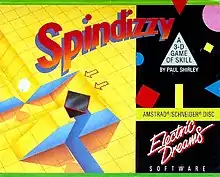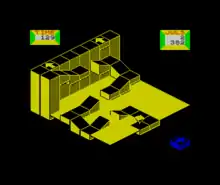Spindizzy (video game)
Spindizzy is an isometric computer game released for several 8-bit home computer formats in 1986 by Electric Dreams Software. It combines action and puzzle game elements. Players must navigate a series of screens to explore a landscape suspended in a three-dimensional space. Development was headed by Paul Shirley, who drew inspiration from Ultimate Play the Game games that feature an isometric projection.
| Spindizzy | |
|---|---|
 Amstrad cover | |
| Developer(s) | Electric Dreams, Loriciels (Thomson) |
| Publisher(s) | Electric Dreams Activision |
| Designer(s) | Paul Shirley |
| Series | Spindizzy |
| Platform(s) | Amstrad CPC, Apple II, Atari 8-bit, Commodore 64, Enterprise 128, Thomson, ZX Spectrum |
| Release | 1986 |
| Genre(s) | Action, Puzzle |
| Mode(s) | Single-player |
The game was successful in the United Kingdom and was well received by the video game press. Reviewers praised its visuals and design, but criticized its audio. Similarities were drawn to Marble Madness, which was released in arcades two years earlier. Spindizzy was followed by a 1990s sequel titled Spindizzy Worlds.
Gameplay

Spindizzy is an action and puzzle game played from an isometric perspective. Players can view the playing field from four angles, and rotate between them. The game takes place in a fictional landscape of interconnected stages suspended in a dimensional space. The player controls a probe called a Gyroscopic Environmental Reconnaissance And Land-Mapping Device (GERALD), via keyboard commands or a joystick. The craft is able to transform between three configurations: a ball, an inverted square pyramid, and a gyroscope, although the difference between each configuration is only visual. Players navigate the probe through the stages to explore the world within a time limit. The time limit can be extended by collecting power jewels scattered through the world and is decreased by falling off a stage. Stages feature ramps, corridors, and other obstacles that hinder the player from quickly traversing them. The game ends when time expires or the world is completely explored.[1][2]
Development and release
Spindizzy was developed by Paul Shirley of British video game developer Electric Dreams Software. He was primarily inspired by Ultimate Play the Game games that feature an isometric projection, but was also influenced by the gameplay of the 1984 arcade game Marble Madness. Shirley created an interpreted script to generate the game's levels. The script allowed him to design a large number of stages using 11KB of storage. The game was originally released for the Commodore 64 and Amstrad CPC. It was later ported to Atari 8-bit, ZX Spectrum, and Apple II computers.[3] Spindizzy cartridges were promoted as prizes in magazine contests upon its release.[4][5] American video game company Activision published the game in the United States as part of its "Electric Dreams" series.[6] John Sanderson programmed the Apple II version; Shirley was unaware of the port's existence until the mid-1990s.[3][7] Spindizzy was later re-released as part of an Activision compilation.[8] The company sold Spindizzy's compilation rights not long after obtaining them, which reduced the amount of royalties to Shirley and Electric Dreams. Shirley eventually severed the contract with Activision, citing late royalty payments among other actions he disagreed with.[3]
Reception and legacy
| Publication | Score |
|---|---|
| AllGame | 4 out of 5[9] |
| Amstrad Action | 96%[10] |
| Crash | 93%[2] |
| Your Sinclair | 9 out of 10[11] |
| Zzap!64 | 98%[1] |
| Publication | Award |
|---|---|
| Crash | Crash Smash |
| Zzap!64 | Gold Medal |
| Amstrad Action | 3rd best game of all time [12] |
Spindizzy sold well in the United Kingdom.[6] Shirley described the game's marketing life as short and attributed that to Activision's business practices. James Hague of Dadgum Games commented that Spindizzy could have been an "all-time classic" had it received a proper marketing campaign.[3] The game was well received by video game journalists upon its release. Zzap!64 awarded Spindizzy a Gold Medal.[1] Tony Hetherington of Computer Gamer listed it as one of the essential Spectrum titles of 1986.[13]
Praise from reviewers focused on the game's visuals and design, while criticism focused on the audio. Three of Zzap!64's reviewers—Julian Rignall, Gary Liddon, and Gary Penn—called the graphics "amazing", well-executed, and "varied"; but they described the audio as sparse. Rignall and Penn complimented the challenging gameplay and commented that its addictiveness outweighed any frustration experienced while playing. The three summarized by urging readers to purchase the game.[1] Computer Gamer reviewer Mike Roberts praised Spindizzy's gameplay, but mentioned that the screen's orientation can require a period of adjustment, particularly when using a joystick.[14] Crash's reviewer called Spindizzy "one of the most addictive" ZX Spectrum games, noting its innovative use of shape changing, multiple view angles, and speed control. The audio was seen as lacking compared to the rest of the game, but was still described as good.[2] Phil South of Your Sinclair gave the game high marks for graphics, playability, value for money, and addictiveness. He praised the ability to change viewpoints and the realistic movements of the character sprite. He also lauded the speed and quality of the graphics.[11] Info gave the Commodore 64 version four stars out of five, describing it as "a hot little number with much of the appeal of Marble Madness" but better; "Yep, it's a winner ... Recommended".[15]
Roy Wagner reviewed the game for Computer Gaming World, and stated that "This game has a lot to offer and is an excellent value."[16]
More than a decade later, reviews still praised the game. Allgame editor Ryan Glover called Spindizzy an "innovative puzzler" that prompts players to fully explore it.[9] Saying that the game successfully mixed infuriating moments with brilliant design, Darran Jones of Retro Gamer called Spindizzy a "timeless classic".[17] The magazine rated Spindizzy the second best game with an isometric perspective, citing its presentation and stage designs.[18] Reviewers drew comparisons to Marble Madness, which was ported to home platforms the same year. Roberts called Spindizzy the "best 'marble' game yet",[14] and Charles Ardai of Computer Gaming World called it "a thoroughly enjoyable game" superior to Marble Madness.[19] South described Spindizzy as the "closest thing yet to Marble Madness" on the ZX Spectrum, while Liddon said that any similarities to Marble Madness were coincidental.[1][11] Many publications commented that the game was obviously inspired by Marble Madness.[2][20][21][22] Over 25 years after its release, Retro Gamer called the game "intensely devious and addictive" and added that "Spindizzy's only enemy was yourself".[23]
Spindizzy's isometric design partially inspired Glenn Corpes during the development of the 1989 title Populous.[24] Activision released a sequel titled Spindizzy Worlds for Amiga and Atari ST computers in 1990.[3] The game features similar gameplay, but improved graphics and larger playing fields.[25] It was later ported to the Super Nintendo Entertainment System by ASCII, which Shirley disapproved of and considered it a "disaster". He took legal action over the span of several years to obtain royalty information and payments.[3]
See also
- Gyroscope: A 1985 video game with similar design and gameplay
- Bobby Bearing: A 1986 video game with similar design and gameplay
References
- "Zzap! Test: Spindizzy". Zzap!64. Newsfield Publications (14): 108–109. June 1986.
- "Spindizzy". Crash. Newsfield Publications (29): 16–17. June 1986.
- James Hague, ed. (1997). "Paul Shirley". Halcyon Days: Interviews with Classic Computer and Video Games Programmers. Dadgum Games.
- "Spindizzy Competition". Computer and Video Games. EMAP (57): 72. July 1986.
- "A Really Rather Big Competition". Your Sinclair. Dennis Publishing (8): 38–39. August 1986.
- Bateman, Selby (October 1986). "A Great Year For Games". Compute!. Small System Services (77): 18.
- "Spindizzy – MobyGames". MobyGames. Retrieved 2010-01-18.
- "Spindizzy". Your Sinclair. Dennis Publishing (64): 8. April 1991.
- Glover, Ryan. "Spindizzy – Overview". Allgame. Archived from the original on 2014-11-15. Retrieved 2010-01-16.
- "Spindizzy". Amstrad Action. Future Publishing (6): 58–59. March 1986.
- South, Phil (July 1986). "Spindizzy". Your Sinclair. Dennis Publishing (7): 60–61.
- http://retroactionmagazine.com/retroactionextra/amstrad-action-all-time-top-10-games/
- Hetherington, Tony (August 1986). "The Spectrum Collection Update". Computer Gamer. Argus Specialist Publications (17): 14.
- Roberts, Mike (April 1986). "Spindizzy". Computer Gamer. Argus Specialist Publications (13): 30–31.
- Dunnington, Benn; Brown, Mark R.; Malcolm, Tom (January–February 1987). "64/128 Gallery". Info. pp. 14–21.
- Wagner, Roy (January–February 1987). "Commodore Key". Computer Gaming World. 1 (34): 39.
- Jones, Darran. "Retrorevival: Spindizzy". Retro Gamer. Imagine Publishing (52): 22.
- "Top 25 Isometric Games". Retro Gamer. Imagine Publishing (59): 73.
- Ardai, Charles (June–July 1987). "Titans of the Computer Gaming World / Part Three of Five: Ardai on Activision" (PDF). Computer Gaming World (38). p. 36.
- Bryan Ralph, ed. (July 1986). "Spindizzy". ZX Computing Monthly. Argus Specialist Publications: 65.
- "Frontlines". Your Sinclair. Dennis Publishing (6): 13. June 1986.
- Grannell, Craig (August 2008). "The Making of Marble Madness". Retro Gamer. Imagine Publishing (53): 82–87.
- Mason, Graeme (July 2012). "From the Archives – Electric Dreams". Retro Gamer. Bournemouth: Imagine Publishing (104): 84. ISSN 1742-3155. OCLC 489477015.
- Edge Staff (February 2002). "The Making Of: Populous". Edge. Future Publishing (107). Archived from the original on July 10, 2012. Retrieved 2010-01-17.
- Webb, Trenton (January 1991). "Screenplay: Spindizzy Worlds". Amiga Format. Future Publishing (18): 82–84.